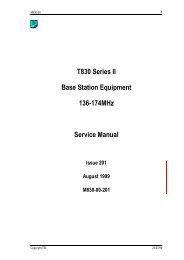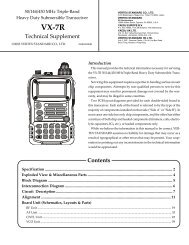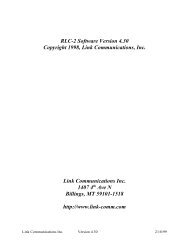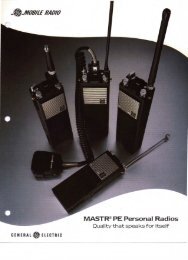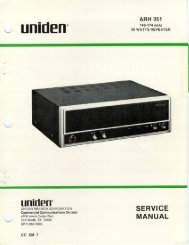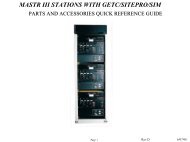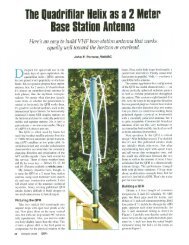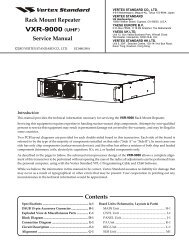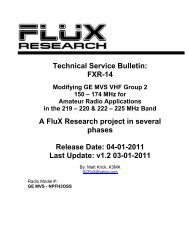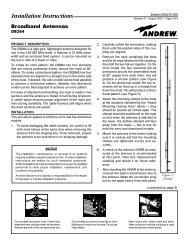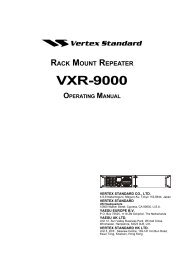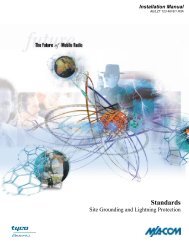TK-880/H (UHF) mobile service manual - The Repeater Builder's ...
TK-880/H (UHF) mobile service manual - The Repeater Builder's ...
TK-880/H (UHF) mobile service manual - The Repeater Builder's ...
Create successful ePaper yourself
Turn your PDF publications into a flip-book with our unique Google optimized e-Paper software.
OPERATING FEATURES<br />
<strong>TK</strong>-<strong>880</strong>/H<br />
■ Sub LCD display<br />
You can use 3-digit the display to display the system<br />
number, channel number or group number. It is useful<br />
when the main (12-digit) display indicates system, group or<br />
channel name or other functions.<br />
■ Selective call alert LED<br />
You can select whether or not the LED on the transceiver<br />
flashes in an orange color when selective call was occurred.<br />
■ PTT ID<br />
PTT ID provides a DTMF or MSK (FleetSync : Fleet-ID)<br />
ANI to be sent with every time PTT (beginning of transmission,<br />
end of transmission, or both).<br />
You can program PTT ID for each group. You can program<br />
a PTT ID as “on” or “off” when “DTMF” is selected<br />
for the PTT ID type. You can program a PTT ID as “own”,<br />
“sel” or “off” when “MSK” is selected for the PTT ID type.<br />
<strong>The</strong> contents of ID are programmed for each transceiver.<br />
<strong>The</strong> timing that the transceiver sends ID is programmable.<br />
BOT : DTMF ID (BOT)/MSK ID is sent on beginning of<br />
transmission.<br />
EOT : DTMF ID (EOT)/MSK ID is sent on end of transmission.<br />
Both : DTMF ID (BOT)/MSK ID is sent on beginning of<br />
transmission and DTMF ID (EOT)/MSK ID is sent on end<br />
of transmission.<br />
■ Radio password<br />
When the password is set in the transceiver, user can not<br />
use the transceiver unless enter the correct password.<br />
This code can be up to 6 digits from 0 to 9 and input with<br />
the key, and "S" key.<br />
■ Off hook decode<br />
If the Off hook decode function has been enabled, removing<br />
and replacing the microphone on the hook has no<br />
effect for decoding QT/DQT and option signalling.<br />
■ Timed power off<br />
This function works as “Automatic Power Switch Off”.<br />
Timed power off timer starts from the ignition-off. After<br />
the timer expires, the radio will automatically turn off. <strong>The</strong><br />
timer will be reset if the ignition is turned on and off.<br />
This function requires ignition-sense. Connect the ignition-line<br />
to the 9-pin connector which is located at the rear of<br />
the radio.<br />
After the timer expires, press the power switch to turn<br />
on the radio.<br />
■ Horn alert<br />
In trunking format, horn alert can be set to on or off for<br />
each group. If horn alert has been set to YES for a group and<br />
DEC ID/QT/DQT matches, the horn alert, HOR. is turned on<br />
and off. <strong>The</strong> group for which the optional signalling is set<br />
works by ANDing the decode ID/QT/DQT with the optional<br />
signalling.<br />
In conventional format, if you are called from the base<br />
station using 2-tone/DTMF while you are away from your<br />
transceiver, you will be alerted by the vehicle horn or some<br />
other type of external alert. To turn horn alert function on,<br />
press the [Horn Alert] key.<br />
Either continuous or non-continuous operation can be set<br />
by the FPU. <strong>The</strong> horn alert port is enabled or disabled as<br />
follows;<br />
Off hook horn alert Hook off Hook on<br />
Enable Yes Yes<br />
Disable No Yes<br />
■ Pulse<br />
<strong>The</strong> horn alert port, HOR, is turned on and off as follows;<br />
0.5s 0.5s 0.5s 0.5s 0.5s<br />
<strong>The</strong> timing when the fixed LTR ID matches is as follows<br />
(trunking format);<br />
1s 0.5s 1s<br />
HOR<br />
■ Continuous<br />
Horn alert can be reset by setting an expiration time from<br />
the FPU, pressing the AUX-A key, or setting off hook.<br />
■ Data TX with QT/DQT<br />
Whether programmed QT/DQT is modulated or not with<br />
a data transmission except for Selcall. A radio unit can receive<br />
a data message regardless of QT/DQT if the receiving<br />
unit is not scanning.<br />
9



